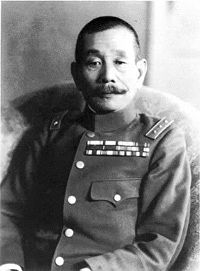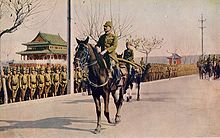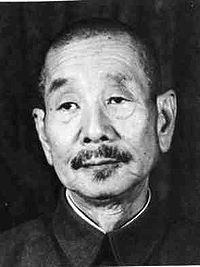- Iwane Matsui
-
Iwane Matsui 
General Iwane MatsuiBorn July 27, 1878
Aichi prefecture, JapanDied December 23, 1948 (aged 70)
Tokyo, JapanAllegiance Empire of Japan Service/branch  Imperial Japanese Army
Imperial Japanese ArmyYears of service 1904–1938 Rank General Commands held IJA 35th Brigade, IJA 11th Division, IJA 10th Army, Shanghai Expeditionary Force Battles/wars Russo-Japanese War
Second Sino-Japanese WarAwards Order of the Golden Kite, Order of the Rising Sun Iwane Matsui (松井 石根 Matsui Iwane, extra 27 July 1878 – 23 December 1948) was a general in the Imperial Japanese Army and the commander of the expeditionary forces sent to China in World War II. He was convicted of war crimes and sentenced to death by hanging by the International Military Tribunal for the Far East for responsibility over the Nanking Massacre.
Contents
Early life and education
Matsui was born in Aichi prefecture as the sixth son of a former samurai retainer of the Tokugawa clan of Owari han. Matsui graduated from the 9th class of the Imperial Japanese Army Academy in 1897. His classmates included future Prime Minister Nobuyuki Abe, and generals Sadao Araki, Jinzaburo Mazaki and Shigeru Honjō.
Early military career
Matsui fought in the Russo-Japanese War of 1904–1905, and graduated from the 18th class of the Army Staff College in 1906. He became commanding officer of the 29th Regiment from 1919 to 1921.
From 1921 to 1922, Matsui was attached to the Vladivostok Expeditionary Force Staff for the Japanese Siberian Intervention against Bolshevik Red Army forces in eastern Russia. From 1922 to 1924, he was transferred to military intelligence and made head of the Harbin Special Services Agency in Manchuria. Matsui was then made commanding officer of the IJA 35th Infantry Brigade until 1925. From those posts he was sent to be head of the 2nd Bureau of the Imperial Japanese Army General Staff from 1925 to 1928, then attached to the Army General Staff until 1929 when he was promoted to major general and assigned command of the IJA 11th Division until 1931.
From 1931 to 1932, Matsui was a member of the Japanese delegation to the Geneva Disarmament Conference and then again attached to the Army General Staff until 1933.
Matsui attained the rank of general in 1933, and was appointed a member of the Supreme War Council until 1935, except for the period from 1933 to 1934 when he was Commander in Chief of the Taiwan Army. In 1933 he became one of the initiators of “Greater Asia Association”, and also established a “Taiwan-Asia Association”. He was also awarded the Order of the Rising Sun, 1st class for his career efforts, and went into retirement from active military service in 1935.
Second Sino-Japanese War
Command of the Shanghai Expeditionary Force
However, with the start of the Second Sino-Japanese War, Matsui was recalled to duty on 15 August 1937 to become the commander of the Japanese Shanghai Expeditionary Force (SEF) during the Battle of Shanghai. Japanese historian Hiroshi Yoshida said in his biography of Prime Minister Fumimaro Konoe that Matsui had been hand-picked for the position by Emperor Hirohito due to his friendship with Kuomingtang leader Chiang Kai-shek.
On leaving the Imperial Palace in Tokyo, Matsui remarked to War Minister Hajime Sugiyama that: "There's no solution except to break the power of Chiang Kai-shek by capturing Nanking. That is what I must do.":[1]
On 23 August, the SEF arrived in Shanghai, and was reinforced with the Japanese Tenth Army commanded by Lieutenant General Heisuke Yanagawa later in October. On 7 November, Japanese Central China Area Army (CCAA) was organized by combining the SEF and the 10th Army, with Matsui appointed as its commander-in-chief concurrently with that of the SEF. After winning the battles around Shanghai, the SEF suggested the Imperial General Headquarters in Tokyo to attack Nanking. The CCAA was rearranged and Lieutenant General Prince Asaka (Yasuhiko), an uncle of Emperor Hirohito, was appointed as the commander of the SEF, while Matsui stayed as the commander of CCAA overseeing both the SEF and the 10th Army. The real nature of Matsui's authority is however difficult to establish as he was confronted with a member of the imperial family directly appointed by the Emperor. In anticipation of the attack on Nanking, Matsui issued orders to his armies that read:
Nanking is the capital of China and the capture thereof is an international affair; therefore, careful study should be made so as to exhibit the honor and glory of Japan and augment the trust of the Chinese people, and that the battle in the vicinity of Shanghai is aimed at the subjugation of the Chinese Army, therefore protect and patronize Chinese officials and people, as afar as possible; the Army should always bear in mind not to involve foreign residents and armies in trouble and maintain close liaison with foreign authorities in order to avoid misunderstandings.
On 10 December 1937, the SEF began its attack on Nanking, and the Kuomintang forces that remained surrendered on 13 December 1937. The Nanking massacre began immediately afterwards. Matsui and Asaka marched triumphantly into Nanking on 17 December 1937.
While Matsui himself was not present during the beginning of the atrocities (he was ill at the time), he was aware of what his men were doing in the city, as were members of the Japanese foreign service who had followed the army into the city. Word began to trickle out of Nanking, and growing pressure was placed on the Imperial government to recall the SEF's officers.
Nanking Massacre
Concerning atrocities in Nanking, Matsui wrote in his war journal about rapes (20 December) and looting (29 December) and wrote it was very much regrettable that these behaviours destroyed the reputation of the Imperial Japanese Army. He also mentioned "a number of abominable incidents within the past 50 days" at the memorial service for the war-dead of the SEF held on 7 February[2] and rebuked, in tears, the officers and the soldiers in the place, saying that atrocities done by a part of the army had damaged the reputation of the empire, such a thing should not happen in the Imperial Army, they should maintain discipline strictly and should never persecute innocent people, and so on.[3]
Second retirement
Both Matsui and Asaka were recalled to Japan in 1938. Matsui retired again from the military, and returned to his hometown of Atami, Shizuoka prefecture. Along with several others in the community, he built a large statue of Kannon, the Buddhist Goddess of Mercy, facing in the direction of Nanking.
Trial
Arrested by the American occupation authorities after the surrender of Japan, Matsui was charged with war crimes in connection with the actions of the Japanese army in China. In 1948, the International Military Tribunal for the Far East (IMTFE) found him guilty of class B and C war crimes, and he was hanged that December at Sugamo Prison, alongside six others, including Hideki Tōjō. He was 70 at the time of his death.
Evidence
In court, Muto straightforwardly admitted that what the prosecutors dubbed "the Rape of Nanking" took place. There were many other Japanese witnesses who acknowledged that there were excesses of Japanese troops in Nanking, though their perceptions as to the scale of the atrocities varied.
Among the most candid witnesses was Ishii Itaro, the East Asia Bureau chief of the Foreign Ministry. He testified that he was briefed about the rape, arson, looting, and murders from Foreign Ministry offices in Nanjing and Shanghai. In his autobiography, Ishii wrote that he and Foreign Minister Hirota Koki had warned the Army many times to take action.
Verdict and sentence
In their decision, the Tribunal wrote:
The Tribunal is satisfied that Matsui knew what was happening. He did nothing, or nothing effective to abate these horrors. He did issue orders before the capture of the city enjoining propriety of conduct upon his troops and later he issued further orders to the same purport. These orders were of no effect as is now known, and as he must have known. It was pleaded in his behalf that at this time he was ill. His illness was not sufficient to prevent his conducting the military operations of his command nor to prevent his visiting the City for days while these atrocities were occurring. He was in command of the Army responsible for these happenings. He knew of them. He had the power, as he had the duty, to control his troops and to protect the unfortunate citizens of Nanking. He must be held criminally responsible for his failure to discharge this duty.
Historical assessment
The first edition of The Rape of Nanking, by Iris Chang, followed the IMTFE's lead in blaming Matsui for the massacre arguing the traditional view that Matsui planned the invasion of Nanking and was Asaka's commanding officer during the Rape. Chang however revised her position in subsequent editions and insisted on the fact that Matsui was sick during the massacre and that Asaka was therefore the officer in charge.
James Yin and Shi Young's book of the same title also blames Asaka for the massacre, and portrays Matsui as a helpless figurehead stuck between a prince and an emperor. The truth is a matter of continued debate.
Notes
- ^ Yoshida, Hiroshi. Tennō no guntai to Nankin jiken 1998 Aoki shoten, ISBN 4-250-98019-7, p.71
- ^ Higashinakano, Shudo. The Nanking Massacre: Fact Versus Fiction 2005 Sekai Shuppan, Inc. http://www.sdh-fact.com/ ISBN 4-916079-12-4, ISBN 4-916079-13-2, p.171; the original Japanese edition: Nankin gyakusatsu no tettei kensho 1998 Tendensha ISBN 4-88656-153-5 C0021, p.263)
- ^ Yoshida Hiroshi Tennou no guntai to Nankin jiken 1998 Aoki Shoten, ISBN 4-250-98019-7, p.164
References
- Higashinakano Shudo The Nanking Massacre: Fact Versus Fiction 2005 Sekai Shuppan, Inc. ISBN 4-916079-12-4, ISBN 4-916079-13-2, http://www.sdh-fact.com/ (Original Japanese edition: Nankin gyakusatsu no tettei kensho 1998 Tendensha ISBN 4-88656-153-5 C0021)
- Yoshida Hiroshi Tennou no guntai to Nankin jiken 1998 Aoki shoten, ISBN 4-250-98019-7.
External links
- Ammenthorp, Steen. "Iwane Matsui". The Generals of World War II. http://www.generals.dk/general/Matsui/Iwane/Japan.html.
- 興亜観音ホームページ at www.history.gr.jp
Military offices Preceded by
Nobuyuki AbeCommander, IJA Taiwan Army
Aug 1933 – Aug 1934Succeeded by
Hisaichi TerauchiPreceded by
noneCommander, Shanghai Expeditionary Army
Aug 1937 – Dec 1937Succeeded by
Prince Asaka YasuhikoPreceded by
noneCommander, Japanese Central China Area Army
Oct 1937 – Feb 1938Succeeded by
noneCategories:- Japanese people convicted of war crimes
- 1878 births
- 1948 deaths
- People from Aichi Prefecture
- Japanese generals
- Japanese military personnel of the Russo-Japanese War
- Nanking Massacre
- Japanese military personnel of World War II
- Recipients of the Order of the Rising Sun
- Recipients of the Order of the Golden Kite
- Executed generals and admirals
- Japanese people convicted of crimes against humanity
- People executed by the International Military Tribunal for the Far East
- People executed by hanging
Wikimedia Foundation. 2010.


